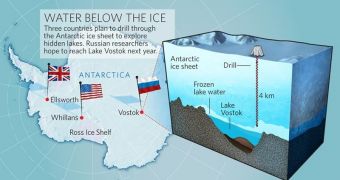Millions of years ago, as Antarctica was covered by plains and mountains, not ice, lakes adorned its surface, as they do on all other continents. As the weather cooled, and ice began to form, the majority of these lakes solidified, and became a part of the thick ice sheet currently covering the Southern Continent. But a small part of these lakes endured. They were covered by a cap of ice, on which miles of other ice deposited itself. Now, researchers are drilling to get to them, for several different reasons, Nature News reports.
The most important is life. With millions of years gone since the microorganisms in these underground lakes had any contact with the outside world, biologists hypothesize that they changed considerably. Finding out how life can evolve within such tightly-closed ecosystems is of tremendous importance for space exploration, among others. If bacteria, microbes and viruses can endure in the freezing, oxygen-free conditions of submerged lakes, then it shouldn't be too far-fetched to believe that the same can happen in the covered ocean of Enceladus, or in the liquid hydrocarbon lakes of Titan.
Using advanced observations methods, geologists and other experts were able to observe the contours of these lakes even through the miles of ice covering them, and have set up experiments to get to them. Three nations are currently engaged in this type of efforts. At a joint meeting they held last week, researchers from the United Kingdom, the United States, and the Russian Federations, described the progress they registered in their drills this far. They also exposed their plans on how to handle this delicate task. All experts involved underlined the fact that breaching the surface of these lakes would need to be conducted in an environment as sterile as an operating room.
Any small contaminants from the outside world could change the ecosystem in a matter of minutes, and so this needs to be avoided at all costs. Still the curiosity to explore the world's last unknown ecosystem is very great. Experts say that these subglacial lakes will be reached next year, as the technology needed to avoid contamination will be produced, delivered to Antarctica, installed, and then operated. Though three groups are working on this type of exploration, there are at least 150 underground lakes under the ices, all of them identified as having various ages and sizes. They will most likely constitute a target for future investigations.

 14 DAY TRIAL //
14 DAY TRIAL //